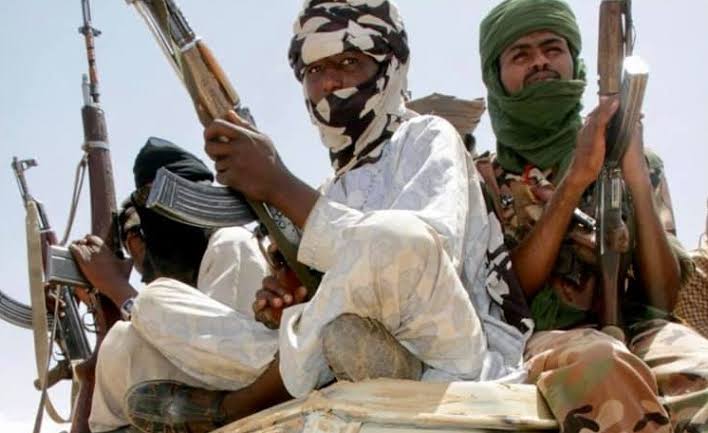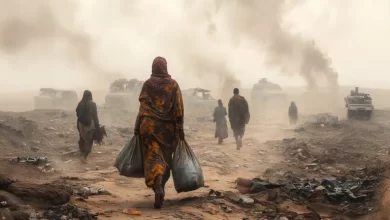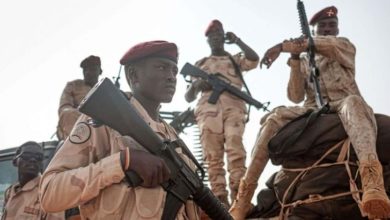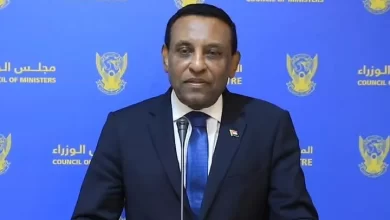After the war entered its second year .. The militia panicked from the source of strength to the weakness

Report – Amir Abdel Majid
Since the beginning of the war that entered its second year, many phrases were repeated, some of which are old and well-known in the history of Sudan and some of which are secretions of the war such as “Al-Matak” and “Al-Jagham” and others, and there is a word that has been widely circulated in the news and reports, which is the word “Al-Fazaa”, so is it from the vocabulary of the current war or is it an old word, and is the meaning currently circulated the same as the meaning of the word in the past if we assume for the sake of argument that it is old, and what is its impact now in this war in which the Rapid Support Forces RSF rely on “Al-Fazaa” to fight its battles.
Combat groups
The common panic here is the mobilization of combat groups to support others in a battle somewhere, which is a societal tradition that some tribes in Kordofan and Darfur are famous for. Ibrahim Abdullah, who held the position of head of the Arab Tribes Shura Council in the city of El Fasher, says that panic is a societal tradition through which members of the tribe in nearby and distant areas are informed of a specific incident through a specific tradition to support them.
In the past, they were informed through Naqara or by sending a specific person to distant areas, but recently the mobile phone has solved that crisis and panic is now called for through phone calls.
It was primarily targeting tribal disputes between tribes, as happened often in Darfur and Kordofan, as soon as a battle breaks out between two tribes, each tribe calls for its supporters and allies to fight the other tribe.
However, things are different now in this war, as with the presence of the tribal system that forms the backbone of the Rapid Support Forces RSF there are other extensions of panic.
The panic here did not stop at calling tribal groups belonging to the ethnicities that form the solid bloc of the Rapid Support Forces RSF only, but rather turned into a military method To carry out operations against the armed forces by circling panic coming from here or there, which turned panic itself into a piece of the military battle, as in addition to the movements that come from outside Sudan with fighters that the militia calls panic, there is panic in most of the battles that we witnessed even inside Khartoum, so when the militia prepares to attack a military base, for example, panic from many areas in Khartoum reaches it for the purpose of attacking until it became a way of fighting until the vision became clear now in the battles of El Fasher, Jebel Moya and Sennar.
Shortage and gathering
It became clear that the panic has transformed from support to being the fighting force, that means that a force present in a certain area goes to support a very small force, so the panic becomes not support for that force but rather the main force, as journalist Abdel Majid Abdel Hamid says, who added, “The battles of Jebel Moya have revealed the most important weaknesses of the rebel militia in recent times, as the militia suffers from a terrible shortage in the number of fighters, that forces it to rotate and transfer them from specific areas in Khartoum and Gezira o fight in Al-Fasher, Jebel Moya and others, a development whose full features will become clear after the battle of Jebel Moya is resolved.” Lt.Col. Salah Mosha said that gathering what is in the maze makes you see the full picture, which is that the current groups have become clear even in their movements, which is easy for the army to eliminate them, as happened in the panic coming from Gezira to Jebel Moya.
These are groups that are moved from here to there to fight. Their number was large at the beginning of the war and their mechanisms were multiple.
Today, the groups themselves have become small and their movement is exposed not only to the air force but to any SAF present in the area, and it has become easy to read the movements of the panic It was easy for the SAF to set up ambushes in which thousands of militia fighters were killed, the last of which was the panic that was heading from Madani to Jebel Moya, led by Hatem Abdel Rahman Anqari.
He continued, “The Rapid Support Forces RSF have lost the solid force that used to lead the battles, and now rely on groups that they move from here to there in an attempt to prolong the war until they reach a political settlement that guarantees their survival.
Therefore, they now rely mainly on the rapid movement of panic in order to raise a large amount of dust that will achieve their goals, which, as I said, has become exposed to those who are leading the battles now in the army.”
He added, “If every force is confined to its place, it will suffocate because its number is small and it can be completely eliminated. Therefore, they are trying through panic to suggest that their numbers are large in the battles, and this is not true. In addition, most of the (Shafshafa) ( thieves)do not participate in the battles and flee from them because they came here to steal and do not want to die.
If we exclude the (Shafshafa), the number of fighters is small, and if we separate them from each other and besiege them, no one will come out.” Dealing with the enemy
The chief expert of the African Center, Lt. Gen. Madani Al-Harith, said, “What happened in Sennar and the vicinity of Jebel Moya explains to everyone that the army has become more capable of dealing with the enemy.”
He added, “The Rapid Support Forces RSF do not now have a large trained fighting force because the main forces were withdrawn to the battles of Al-Fasher and most of them perished there, so those present now are looters and bandits who have cannons that fire from afar and they do not have the ability to confront trained forces that have air support.” He continued, “The Rapid Support Forces RSF now have most of their strength from foreign mercenaries and criminals whom the Rapid Support Forces released from prisons. If you RSF look at the current mercenaries, you will find that most of them are from Chad and South Sudan. These are the current panic of the Rapid Support Forces RSF..”



